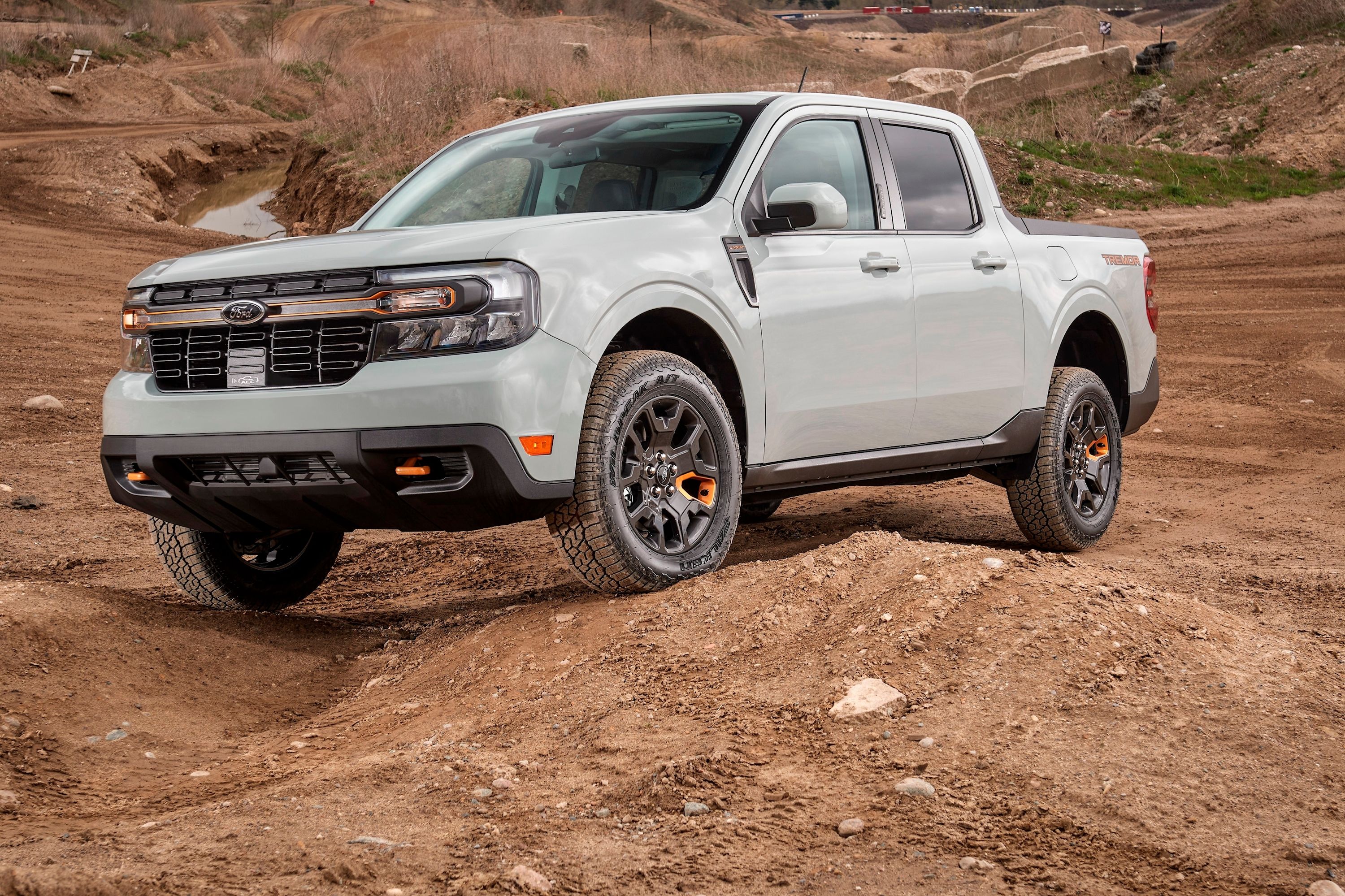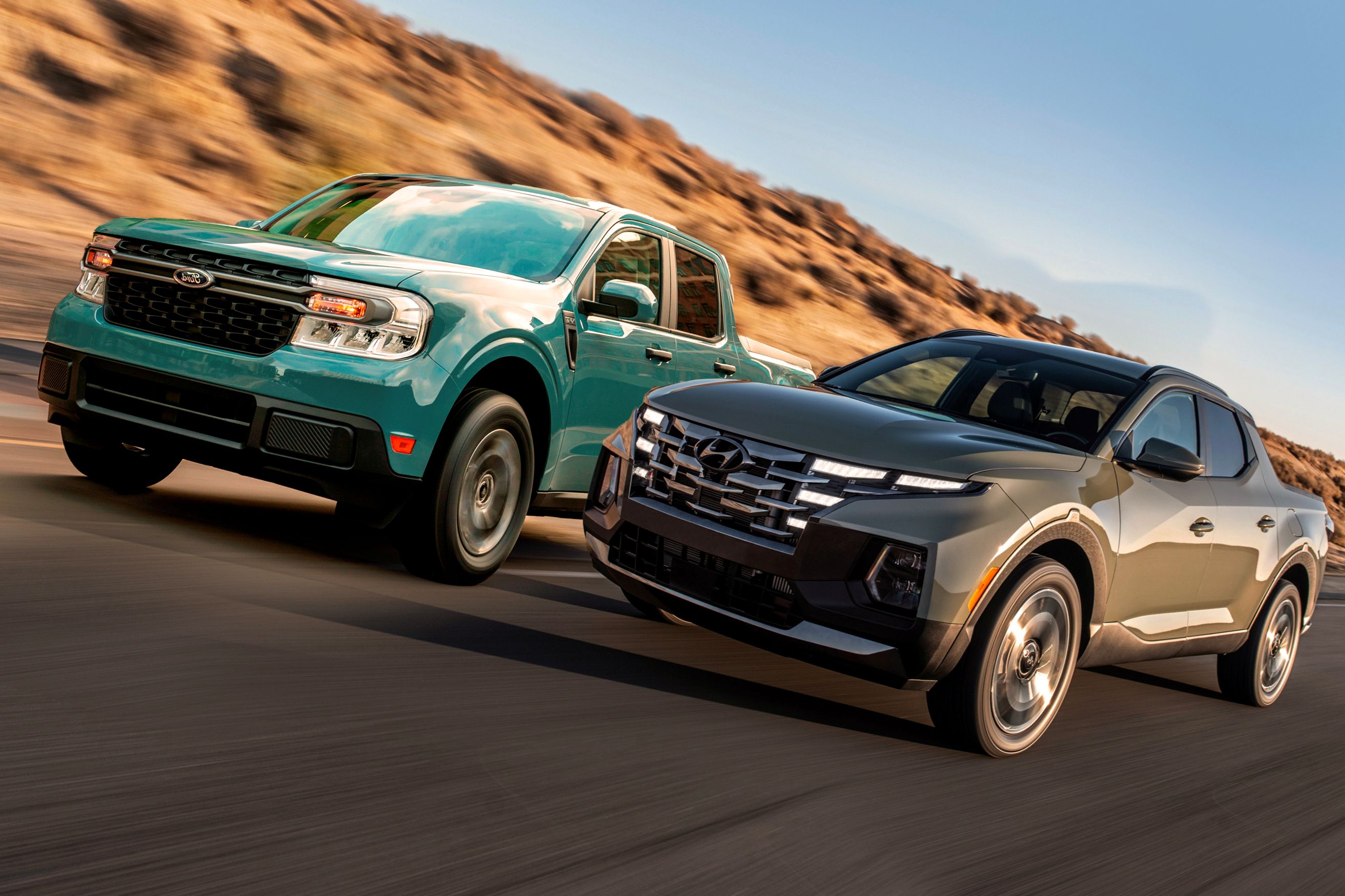
America loves big trucks, but compact vehicles such as the Ford Ranger and Honda Ridgeline have made massive inroads into a market dominated by goliaths such as the Ford F-150 and Chevrolet Silverado. The latest newcomers are the Ford Maverick and Hyundai Santa Cruz which are not only smaller than traditional trucks but ride on a unibody platform, offer impressive fuel economy and cost less than a traditional full-sized truck. That sounds like the perfect combination for cash-strapped millennials looking for a practical workhorse, but the question remains; which is better? The American Maverick, or the Santa Cruz which Hyundai says is not a pickup truck? We break it down to the basics to make the decision a bit easier.
Styling And Design: American Brawn Meets Korean Flair
Ford doesn't like to stray far from the path when it comes to its truck and SUV designs: its cars are bold, brawny, and handsome. Some would say that this is lazy or not very creative, but if it ain't broke don't fix it. The Ford Maverick shares similarities with the Ford Bronco Sport from the front, and the side profile also shares DNA with the Bronco family. The Maverick is said to be riding on the same platform as the Escape and Bronco Sport. The car looks neat, well proportioned, and unoffensive but still modern and masculine enough to qualify as a true Ford pickup. The Ford's bed measures 4.5 feet by 4 feet above the wheel wells.
Hyundai on the other hand doesn't even consider the Santa Cruz to be a pickup truck, and instead calls it a "Sport Adventure Vehicle". It does feature the fundamentals of a pickup, but with some wild styling that you'd never see on something more traditional. The front-end features a staggered headlight unit that integrates with a bold grille while the side profile is a flowing combination of curves and hard angles. We like the way the body angles into the bed (it kinda looks like a Subaru Brat). The bed of the Santa Cruz measures 52.1 inches in length.
The Santa Cruz might appeal to younger buyers who will appreciate its non-traditional looks, but we still prefer the chunky look of the Ford Maverick.
Interior Design: Yin and Yank
As with their exterior designs, the Ford Maverick and Hyundai Santa Cruz take two different approaches to interior design. The Maverick features chunky styling and simple controls that mirror its exterior styling. We love the old-school look of the interior; from the grippy door handles to the clever underseat storage, the Maverick looks like it's ready for adventure. Tech features should also be up there with the best, thanks to Ford's great SYNC infotainment system.
The Santa Cruz takes a more contemporary approach and feels more sporty and road-going compared to the Ford. Its integrated infotainment display is cradled by a number of touch-sensitive controls and the dashboard features a sweeping design that seamlessly incorporates the air vents. The steering wheel too is a non-traditional four-spoke piece that looks good, but we're not sure about its ergonomics. Like the Ford, the Santa Cruz features handy underseat storage, and in higher trims gets premium features such as heated and ventilated seats.
For cars aimed at the young and active, we feel that the Ford's rugged interior best suits this lifestyle. Those more inclined to stay within city limits will appreciate the sporty and more car-like interior of the Hyundai Santa Cruz.
Powertrain And Performance
Despite its non-traditional styling, Hyundai has decided to keep things traditional under the hood. The Santa Cruz is powered by a 2.5-liter four-cylinder engine in base form that develops 190 horsepower and 180 lb-ft of torque. Power is sent to all four wheels via an eight-speed automatic transmission. A more powerful 2.5-liter turbo-four with 275 hp and 310 lb-ft is also on offer and channels its power via an eight-speed dual-clutch transmission. The base engine is capable of towing 3,500 pounds, while the turbo car can manage 5,000 lbs.
The Santa Cruz manages gas mileage figures of 21/27/23 mpg city/highway/combined in base spec with AWD.
Ford took the motoring world by surprise when it announced that the new Maverick would be a hybrid, with the option of a gas-only engine. The base engine is a 2.5-liter Atkinson-cycle four-cylinder hybrid producing 191 hp and 155 lb-ft of torque when combined with an electric motor. Power is sent to the front wheels via a CVT transmission. This combination should be good for 500 miles. The Maverick has a payload of 1,500 pounds and can tow a disappointing 2,000 pounds. Going for the turbocharged 2.0-liter four-pot bags you 250 hp and 277 lb-ft of torque. In this configuration, you can pull 4,000 lbs (when equipped with the 4K Tow Package).
We commend Ford on its bold hybrid move, but when it comes down to it, the Santa Cruz will offer superior outright performance, albeit with a larger fuel bill.
Pricing and Verdict
Ford holds nothing back with its pricing strategy: folks will be able to buy a brand new Ford Maverick for just $20k, which is almost unheard of in this segment, especially considering the fact that the Maverick is a hybrid pickup in base form. At the other end of the spectrum, a fully-loaded Ecoboost First Edition with all the options boxes ticked will set you back $40,640. Hyundai is yet to release official pricing for the Santa Cruz, but we expect it to be competitive.
Both Ford and Hyundai have jumped at the opportunity to fill a gap in the market that is becoming more popular by the day, and both offerings are sure to succeed but will appeal to different markets. Ford has kept to its rugged roots, but put a spin on things by offering the Maverick as a hybrid in base form. Hyundai on the other hand offers a redefined version of the classic pickup truck but sticks to more traditional powertrains. They both look interesting, but the little Maverick is priced ridiculously low and is simply cooler.

